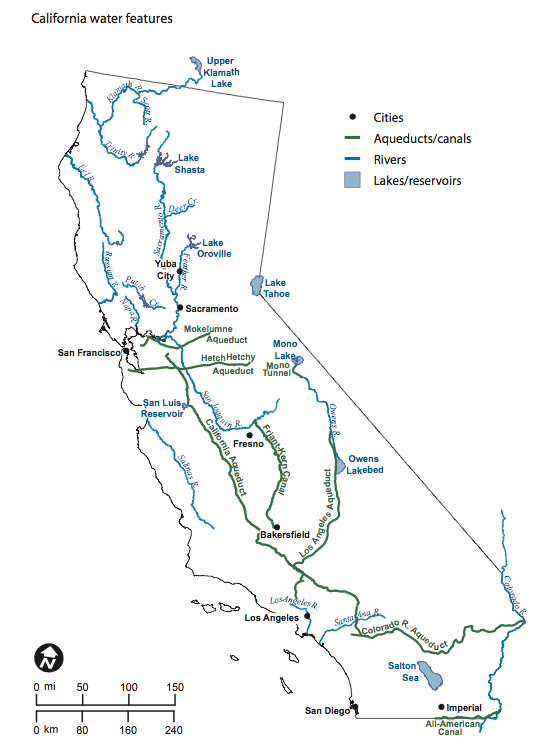The map above outlines the basic water supply issue in California. It's a massive system of
hydraulic engineering developed since over 100 years ago to bring water into the drier areas of the state. While it supplements groundwater supplies and rainwater, it's a system that has been aging in
an increasingly dry climate. There's much higher cost for this processed water, vs. the groundwater via wells; this is the expensive State Water Project (California Aqueduct via the Bay Delta) and Colorado River Aqueduct, which import water over huge distances. Los Angeles also has its own
aqueduct from the Owens River.
Increasing water needs rely upon rebuilding and renovating the
levees in the Bay Delta in order to prop up the
heart of this aging water system in the state of California, which is vulnerable to drought and earthquakes. This year the State Water Project has limited
allocations to nearly zero as the drought impacts water supplies.
Farming operations get the majority of the water. California agriculture
uses about 80% of our water but provides only 5% of economic output. Humans drink less than one gallon of water per day, but livestock consumes up to 23 times that amount of water a day per animal, according to a North Dakota State University study. That’s a huge amount of water to keep millions of animals alive.The ongoing drought and shifts in federal policy are only making water more expensive. The ag farming practices of flooding vast tracts of rice fields and almond trees for export have also become unsustainable, according to the
California Progress Report, basing it on subsidized water to the detriment of California's environmental and
economic future. This has created a political and environmental issue around the Bay
Delta.
So, finally after a couple of political cycles, the legislature has produced a
new version of a water bond to address some of these issues, after subtracting lots of Steinberg pork at Jerry Brown's behest. The new version of the water bond approved by the legislature for November ballot excludes
previously proposed water tunnels in the Delta. Because of these complexities, and the massive groundwater depletion resulting from
these earlier practices, Sacramento is also developing
regulation of underground water for the first time, so that wealthy corporations can't drain a common aquifer that supplies many different cities and farms. The wild, wild west has finally been tamed.
Many cities are now looking beyond groundwater, surface water and imported water, and are developing reclamation systems for existing water. This is a relatively new and very expensive approach to making up for the lack of snowpack and rain in this new climate. It's also affecting the building and development industry, since new subdivisions can't go in
due to lack of water supplies, which are already
vastly oversubscribed. The Los Angeles DWP and the region is looking at
water recycling projects:
"The Upper San Gabriel Valley Municipal Water District, which supplies wholesale water to 1 million residents, is planning a recycled water project to recharge the basin with 10,000 acre feet a year of recycled water. An acre foot is equal to the water used by two families in Southern California per year.The $50 million to $75 million project would move treated water from the Sanitation District’s San Jose Creek Water Reclamation Plant in Whittier eight miles north to existing recharging areas that feed the porous San Gabriel River. It would reduce dependency on imported water by 25 percent, said Shane Chapman, USGVMWD general manager."
This follows a global
trend for desalinization and water recycling, and it's changing the water business and
the resource management practices necessary to conserve the dwindling water supplies. As a result, cities all up and down the coast are planning to install desalinization plants.
Santa Barbara is planning to revive a plant that was previously decommissioned after the last drought ended. The
Carlsbad desalinization plant is under construction just north of San Diego.
Sand City in the Monterey Peninsula has built a desalinization plant.
Huntington Beach is developing a desalinization plant as well, and
Orange County has been recycling water since the 1970's.
Because of this current drought, which is a 100-year event that could last for several decades, California is now facing the biggest challenge the state has had since before it was founded in 1850. Critical cooperation between the water agencies and big users will have to take place. Climate change has come home to roost.
Update 9/08/14:
Delta Stewardship Council Seminar - Expanding desalination capacity along the California coast raises a
variety of environmental, social, and economic questions, many of which
are not fully answered.
Update 9/25/14:
The Associated Press reported the area’s regional water supplier, the Metropolitan Water District of Southern California, could be without reserves by early 2016
Update 12/14/14: from KQED Science:
How California’s Water Rights Make It Tough to Manage Drought
Update 1/12/15: The California Drought: Who Gets the Water and Who's Hung Out to Dry?
Photoessay from EarthJustice
Update 1/19/15:
Chronicling the drought, LA Times
Update 4/24/15:
Drying Up: The Race to Save California From Drought, Newsweek
Update 7/20/16: California Water Fix - Paying for the Delta Tunnels.
At Capitol Weekly's Water 2016 Conference, a panel discusses the fiscal impacts of the California Water Fix
Update 7/30/16: Recently, the Sacramento Bee invited
Jeffrey Kightlinger, General Manager of the Metropolitan Water District, to talk about the California
Water Fix
Update 8/1/16:
Public review for new tunnel diversion points ahead in 2017
Update 2/11/19: The Bay Delta and Statewide Planning Processes Resource Library.
Update 4/29/19: Governor Newsom directs agencies to prepare a water resilience portfolio











